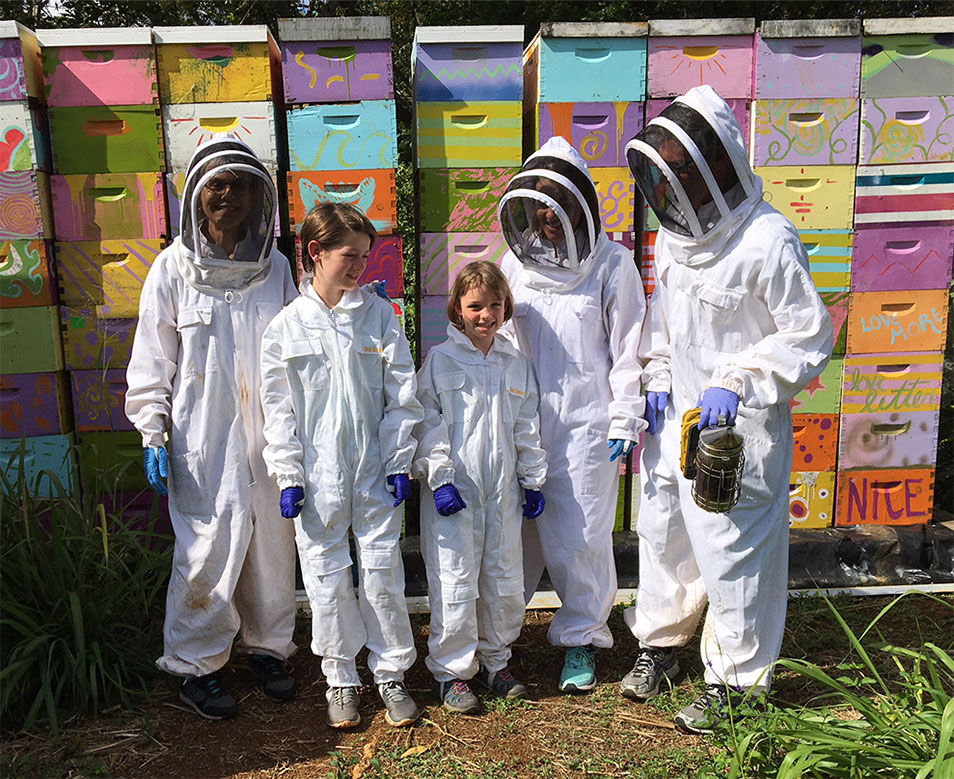by Anna Lappé, Earth Island Journal
Forty percent of insect species are critically endangered. And while many beneficial insects are struggling, some problematic pest species are thriving.
When Robin Fisher was 24 years old and living in California, she got the phone call no one wants: Her mother had died suddenly; her family wanted her to come home. That’s how she found herself a short drive from the tiny Kauaʻi town of Kapaʻa, in the backyard of the house she grew up in, where, nestled inside the jets of a soft-sided jacuzzi, she discovered a beehive. Or, as she would say, the hive discovered her.
With the encouragement and dexterous hands of a friend and renowned local beekeeper, Fisher extracted the hive and, in the process, tumbled into the world of bees. Eight years later, Fisher keeps bees at seven spots scattered from Kauaʻi’s north to south shore, each one home to its own “bee farm” or apiary. From this vantage point, she sees firsthand the impacts of the environment on the smallest creatures among us — and just what is at stake in protecting them.

The author and her family during a visit to some of Robin Fisher’s beehives on a farm on the Hawaiian island of Kaua’i.
I met Fisher and her bees a few months ago and I kept thinking of her as I read a staggering study published in Biological Conservation this spring, the first to gather all the peer-reviewed studies on insect declines from around in the world. Until now, this research had been species- and/or geography-specific — a study of caddisfly declines in Croatia, for instance, or carabid beetles in New Zealand. The aggregated picture is grim: Forty percent of insect species are critically endangered. And while many beneficial insects are struggling, some problematic pest species are thriving. Fisher has observed just this. “Wasps versus bees,” she told me, “We’re seeing an increase in what I call the ‘weeds of the insect world.’”
Beekeepers like Fisher don’t need to be told the important functions insects play, which include not just the headline-garnering fact that we have pollinators to thank for one of every three bites we eat, but the lesser known benefits, too: Insects are vital to nearly every food web in the world and essential players in the web of life: “They break things down, they take care of decaying matter,” Fisher explained.
When I spoke with University of Sydney Professor Francisco Sánchez-Bayo, one of the lead authors of the mega-study, about what’s behind the crisis. He was clear: pollution and habitat loss, both of which are driven by industrial agricultural practices of vast monoculture acreage and widespread pesticide use, particularly a specific class of relatively new insecticides known as neonicotinoids.
On the tiny island of Kauaʻi, Fisher has seen what is possible when bee populations are protected from these agricultural chemicals. Hawai‘i is home to some of the world’s healthiest bees. “On most parts of our island, we don’t have monocrops,” Fisher said. “We have incredible plant diversity.”
But even in Kauaʻi, bee health is threatened by the expansion of monoculture operations controlled by chemical companies like DowDupont and Syngenta that are testing new pesticides and producing genetically engineered seeds for sale on the mainland. Monocultures are terrible for bees, not just because of the problematic pesticides: “Those farms, they’re like a bee food desert,” Fisher says. Bees like hers can roam only a two-mile radius, so a monoculture stretching for miles means trouble.
“Bees are sensitive creatures; they have the ability to show us things that will affect us in the future,” Fisher tells me by phone, standing just a few yards from the very spot where she discovered her first hive. “But they can’t tell us what’s wrong. We have to notice it in the details.”



